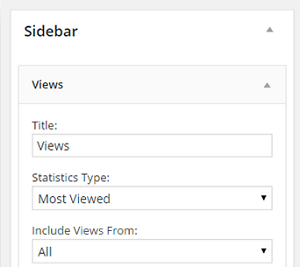Great ad headlines are like the flashy displays you see in store windows every day. They’re there to stop you in your tracks, make you picture yourself owning whatever it is they’re selling, and force you to cross the psychological threshold and walk into the store to buy it.

Of course, window dressing is one way to get prospective customers’ attention, but online, this task falls to your PPC ads. Even if you have the best product or service since sliced bread (or Uber), it won’t matter if you can’t tempt prospects to click on your ads.
We’ve written about the importance of compelling ad copy in the past, but in this post, I’ll be focusing exclusively on how to craft great PPC ad headlines. Here are 21 tips to help you write ad headlines your prospects simply won’t be able to resist clicking.
1. Include Keywords
This one might seem like a no-brainer, but I’m consistently amazed by how many ads I see with vague, ambiguous headlines that don’t feature the keyword I searched for – like the one below. The keyword I searched for was “sportcoats.”
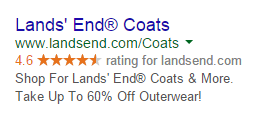
Yes, Lands’ End make sportcoats, but this ad doesn’t offer what I want, so why would I waste time clicking on it?
Don’t make your prospects guess what you sell. Make the connection between their search query and your ad crystal clear by including the keyword in the headline.
2. Ask Questions
Leveraging user intent is crucial to increasing conversion rates. One way to do this is by asking the searcher a question with your headline.

The example ad above is quite clever. Not only does it pose a question in the ad headline, it also uses very particular phrasing (“Protecting your family”) that implies solidarity and dependability – qualities that you could very well be looking for in a divorce attorney.
This is also an exception to the “include the keyword” tip outlined above – although this ad headline doesn’t include the keyword I searched for, it’s still a much more compelling ad than the others I saw. If I were looking for a divorce attorney – which I’m not, by the way! – this ad would get the click.
3. Solve Prospects’ Problems
Perry Marshall, author of the world’s best-selling book on Google AdWords, is always talking about the importance of solving prospects’ problems in your ad copy. This technique is just as crucial when it comes to your ad headlines as it is in the body copy of your ad.
People don’t want to buy “things” – they want to solve their problems.
PPC ad headlines that create the perception that your product or service can help them do that are much more clickable than those that don’t. To learn more about the problem-solving aspect of PPC ad copy, check out this article from PPC University about ad text.
4. Add a Little Humor
Advertisers often pay close attention to the types of ads their competitors are running. Unfortunately, prospects often don’t – all they see are dozens of ads that all look and sound the same.
Differentiating your ads from your competitors’ is vital, and humor can be an excellent way to accomplish this. However, what’s funny to one person might be deeply offensive to another, so if you opt to take this approach, be sure to A/B test your ads to see if your prospects get the joke.
NOTE: If you want to poke a little fun at a competitor as a joke, that’s probably fine. However, be careful about how you choose to do this. Making blatantly false accusations or claims could land you in hot water or lead to sanctions from Google or Bing, even if it’s done in jest.
5. Include Numbers or Statistics
Many users respond well to empirical evidence. Hard data can be a trust signal, and it can plant the seed of trustworthiness in the mind of your prospect. This is why McDonald’s uses its “Billions and billions sold” slogan on its signage.
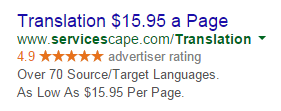
This ad is particularly effective, as the ad headline tells me right upfront how much I can expect to pay (roughly) per page of translated copy. Obviously this could be subject to certain factors, such as the source and desired languages, but this was the only ad I was shown that used hard figures, putting it ahead of the rest by a fair country distance.
It might not be as compelling as Perry’s problem-solving technique, but it gets the point across succinctly (a must when you have so little space to work with), and can create a positive association between your offering and the prospect’s desired outcome. Speaking of outcomes…
6. Think Carefully About User Intent
If you’re not writing PPC ad headlines with user intent in mind, you could be missing out on countless opportunities.
Many companies see PPC ads as a way to wax lyrical about their product’s features. This is a mistake. Remember, nobody cares about you or your product – only how it can solve their problems. Of course, determining what those problems are means thinking about the search that displayed your ad to the prospect in the first place.
7. Use Empathy
As well as wanting to solve their problems, people want to know that somebody else understands what they’re going through. This is what makes empathy such a powerful technique in the best ad headlines. By sympathizing with your customer’s problem, you’re creating a bond between you, which can increase trust – or, at the very least, catch their eye.
8. Use Simple Language
The digital marketing industry has more buzzwords and jargon than many of us care for, and I’m sure you probably use some specialized terms in your industry, too. However, that doesn’t mean you should cram your PPC ad headlines with enough jargon to confuse or deter your prospects.
Use simple, easily understood language in your headlines. It makes them easier to read, more accessible, and more clickable. Don’t put prospects off before you’ve even started by overwhelming them with intimidating and often-useless buzzwords or acronyms.
9. Use Social Trends as Inspiration
Look at what people are talking about in your industry through social media and use that to inspire your headlines.
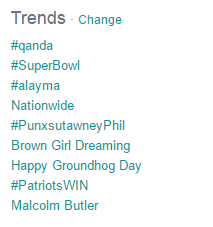
Twitter offers a helpful “What’s trending” section to help you quickly identify trending topics based on your preferences, and hopping on a temporary bandwagon could help you capitalize on social trends to capture additional clicks. Be wary of the (very) fleeting nature of some social trends, though – this is definitely not a “set it and forget it” approach.
10. Make Use of the Character Limit
Don’t use unnecessary words or characters for its own sake, but make sure you take full advantage of the 25-character limit in your PPC ad headlines. Be as descriptive as you can, and make sure that your ads outline exactly what users can expect when they click on them. Speaking of expectations…
11. Don’t Make False Promises or Bogus Claims
Including blatantly false information is a quick way to have your ad disapproved by Google and Bing. If you make a claim in the headline of your ad, make sure either the ad copy or the landing page (preferably both) back it up with real data, customer testimonials, or some other verifiable evidence.

The example above serves as a good example of making claims that can’t easily be verified. According to whom is this site the “No. 1” online fishing tackle shop? This claim isn’t just impossible to prove – it also wastes precious space that could have been used to promote something unique about the business.
Failing to deliver on a promise is one of the fastest ways to harm your brand and lose prospective customers, so don’t write checks your ads can’t cash.
12. Be Obsessive About Punctuation, Spelling, and Grammar
Just because you only have 25 characters to work with in your PPC ad headlines doesn’t mean you shouldn’t spend time making sure your ad is grammatically correct. Misspellings will make you and your business look foolish, so run everything through a spellchecker before submitting your ad for approval.
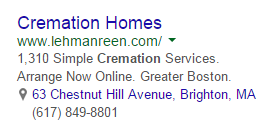
Unfortunately for this business, the ad above is just terrible. First of all, I’m not even sure if this is relevant to my search term (“cremations”). Secondly, I can’t tell if they literally offer 1,310 simple cremation services, or if this means that a simple cremation service costs $ 1,310.
If, like many businesses, you operate in foreign markets (such as Canada and the U.K.), consider using appropriate spellings for those countries. It might not seem like a big deal, but it could make a big difference.
Punctuation is also tremendously important, and can have a profound impact on the meaning of a phrase.
13. Focus on the Benefits…
Similarly to writing PPC ad headlines with user intent in mind, remember that people want to know how choosing your product or service will benefit them. Sales professionals often keep a mantra in mind – “What’s in it for me?” – when talking to prospects, and you should too when writing ad headlines.

Resist the temptation to use your headlines to talk about how awesome you are. Instead, focus on how your product will make your customers’ lives better, like the example above does.
14. …Or Focus on Prospects’ Problems
Let’s say you’ve lost your keys after a night out on the town. Even if you see three or four ads for locksmiths, you’re probably going to be in quite the panic.
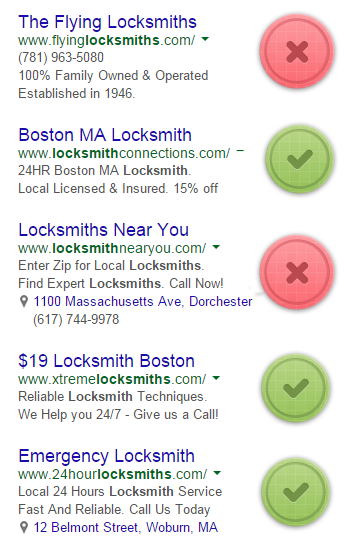
In the examples above, the first ad is the worst. I don’t care if the business is family owned and operated, or one of thousands of franchises owned by Wal-Mart – I just want to get back in my house.
The third ad isn’t much better, as it’s asking me to go to another site and enter my details to find a local locksmith – an unnecessary second step that I’m unlikely to bother with.
The other three ads, however, are exactly what I’m looking for – phrasing that implies reliability, 24-hour service clearly stated, and some pricing information. I am a little curious what makes the fourth business “extreme,” though…
15. Use Fear to Your Advantage
This is another tip Perry Marshall stands by. Leveraging strong emotional responses like fear, suspicion and doubt is an excellent way to get your prospects’ attention and click on your ad.
Check out this example from Perry’s book, “The Ultimate Guide to Google AdWords, 4th Edition,” which shows this technique done extremely well:
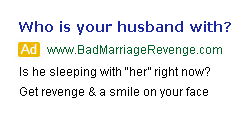
Perhaps not the most ethical ad (or service, whatever it might entail), but there’s no denying that this ad catches the eye and makes excellent use of emotional manipulation to tempt the user to click on it.
16. Emphasize Your USP
Your unique selling proposition is what sets your business apart from the competition. If possible, include this unique feature in your PPC ad headlines. This may not be as effective if your USP isn’t genuinely remarkable, but it’s still worth thinking about, especially if some of the other methods aren’t working as well for you.
17. Think Beyond Dynamic Keyword Insertion
Dynamic keyword insertion, or DKI, is the process by which the keyword used in the search is dynamically inserted into your ad. DKI is a tempting proposition, especially if you’re targeting lots of keywords across several large accounts, but don’t rely on it exclusively.
As Larry pointed out in his popular post on how to triple click-through rates, DKI can increase click-through rates, as you can see in the figure below:
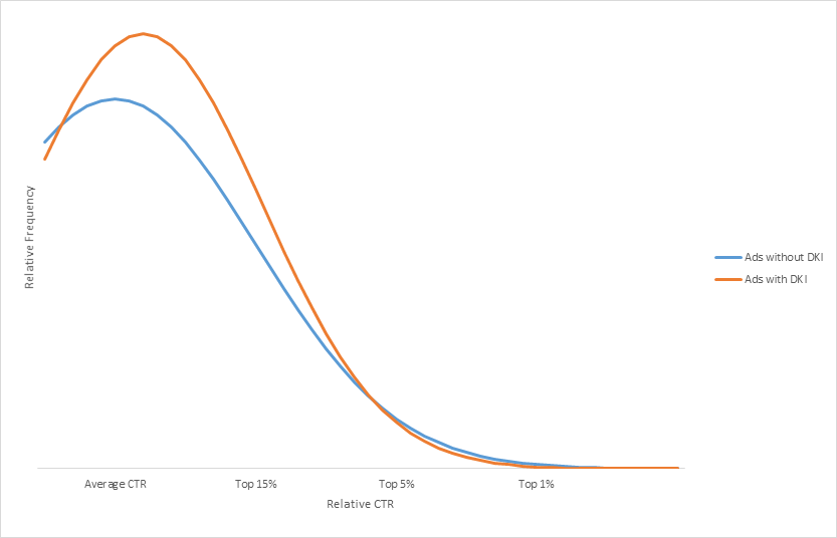
However, you’ll notice that in the top 5% of PPC ads – the unicorns – DKI doesn’t make much of a difference, and ads utilizing DKI actually perform less effectively in comparison to ads without DKI the farther along the graph.
DKI can be a useful tool, but you should also take the time to create genuine, unique PPC ad headlines that really speak to your prospects, too.
18. Include Quotes or Testimonials
If you have a loyal fan base or die-hard customers, put ‘em to work for you and include some of their quotes and glowing testimonials in your PPC ad headlines. However, exercise caution when using quotes, as this can sometimes backfire.
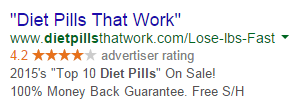
The example above tries to use this technique, but the results aren’t exactly clear. In this content, it’s not immediately obvious if the quoted headline is an actual quote, or whether it’s a testimonial. It could even be interpreted as making fun of the notion that diet pills work. Forget the suspicious-looking URL – the quotation marks in this example clearly need some work.
Use quotation marks to make it obvious that you’re quoting someone, and make their quote or testimonial relevant to the ad. If the quote includes a direct benefit of using your product or service (such as “I saved so much time!”), all the better.
19. Make Promises or Guarantees
Making a firm commitment to your prospect with your PPC ads can signify confidence in your product or service, which can be a powerful motivator for the consumer. This is especially effective if your business is operating in a competitive or crowded market. If you can’t fit promises like free shipping or a money-back guarantee in the headline, definitely consider adding it to the copy.

However, if you decide to make a promise in your PPC ad headlines, you MUST be able to deliver. If you don’t, you could do irreparable harm to your brand and credibility.
20. Be Crystal Clear About What You’re Offering
A lot of advertisers rely on trickery to convince you to click, but in many cases, this is the wrong approach. If a prospect is in the market for what you’re selling, you don’t need to trick them to buy from you – you just need to give them what they want.

The headline of the ad above is pretty much as simple and straightforward as it could be. It also uses the first line of copy to emphasize the benefit of the product.
Be clear and concise with your PPC ad headline copy. If the other tips aren’t working for you, simplify your approach and make your headlines as simple and clear as possible. That way, you eliminate any possible confusion about what you’re offering.
21. Spy on the Competition and Steal Their Ideas
Corporate espionage is great for business! Fortunately, you don’t need to break into the corporate headquarters of your biggest rival or hack into their computer systems to see what kinds of ads are working for them.
Tools such as SpyFu and SEMrush allow you to examine which keywords are performing well for other companies in your sector, as well as gain valuable insight into other areas of their campaigns such as landing pages. I’m not advocating for stealing ideas outright, but a little competitive intelligence could give you the edge you’re looking for.
Well, that about does it for this post. If you have any tips and techniques for great ad headlines that I didn’t cover, please be sure to share them in the comments!
(316)
Report Post
